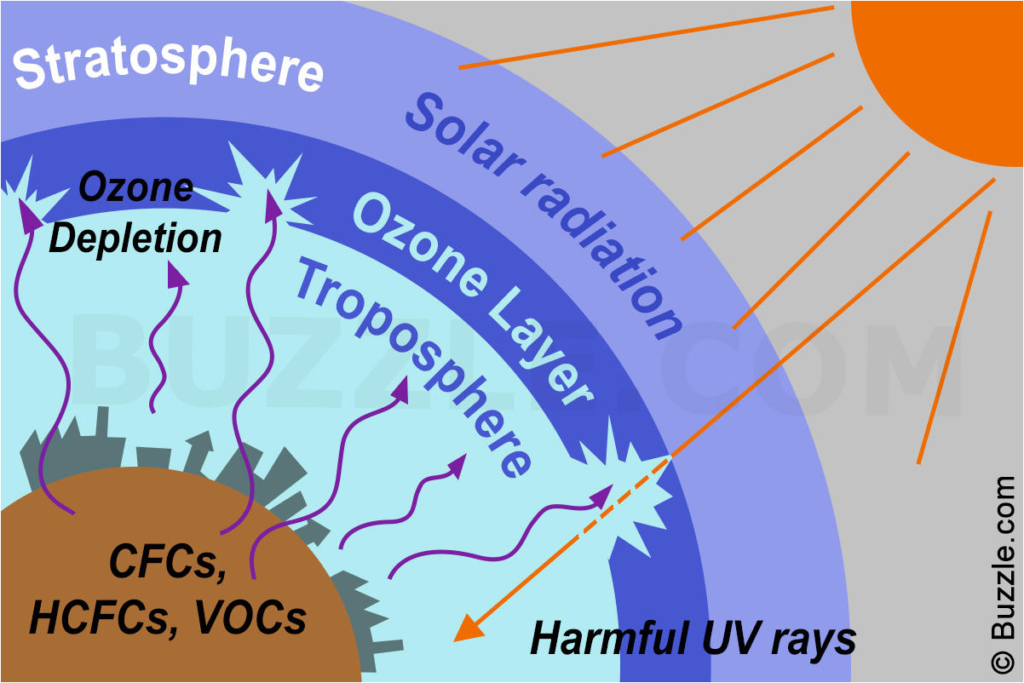- You must enroll in this course to access course content.
Back to: BASIC SCIENCE JSS3
Welcome to class!
In today’s class, we will be talking about the depletion of the ozone layer. Enjoy the class!
Environmental Hazard – Depletion of the Ozone Layer

The ozone layer, or ozone shield, is a region of earth’s atmosphere that contains a high concentration of ozone (O3). It is mainly located in the lower portion of the stratosphere and it is found 20-30km above the earth surface. Ozone layer help to shields, protect the earth, by absorbing harmful ultra-violet radiations from the sun, and makes it not coming directly to the earth surface.
Exposure to dangerous ultraviolet radiation from the sun is harmful and can cause skin cancer, damage to the immune system, loss of various plant species, and can kill microorganisms.
Importance of the ozone layer
The ozone layer is very important because it shields and makes the earth habitable by absorbing harmful ultraviolet radiations that are coming directly from the sun. In the absence of ozone layer, the ultraviolet radiations coming from the sun will reach the earth surface directly and can cause many problems such as skin cancer, loss of aquatic lives, damage to the immune system, cataract, loss of crops, etc. Ozone layer also brings a cooling effect to the atmosphere and the earth surface.
The hazard of depletion of the ozone layer
As ozone depletes in the stratosphere, it forms a hole in the layer. These holes enable harmful ultraviolet rays to get directly into the earth’s atmosphere.
This escape ultraviolet radiation is associated with many health-related and environmental issues. Some of the effects of depletion of the ozone layer are:
- Skin cancer: Exposure of the body to the direct ultraviolet radiation from the sun can pose the risk of developing several skin-related cancers.
- Immune system damage: Exposure of the body to direct ultraviolet radiation from the sun can weaken the response of the immune system.
- Eye damage: Direct exposure of the eyes to ultraviolet radiation can result in eye problems such as cataracts and photokeratitis.
- Respiratory problem: Direct exposure of the body to ultraviolet radiation can cause chest pain, throat irritation, and difficulty in breathing.
- Poor growth of plants: Growth of plants may be hindered by direct ultraviolet radiation from the sun.
- Ageing of the skin: Exposure of the body to direct ultraviolet radiation can lead to rapid/accelerated ageing of the skin. This makes one look older than the normal age.
- Global warming: Ozone layer depletion leads to a decrease in the content of ozone in the stratosphere and an increase in ozone present in the lower atmosphere. This ozone in the lower atmosphere is considered a pollutant and greenhouse gas. This is ozone in the lower atmosphere contributes to global warming and climate change.
Control measures against ozone layer depletion
Some of the control measures to take against the depletion of the ozone layer include:
- Regulation on the use of Chlorofluorocarbons (CFCs).
- Bush burning, which releases smoke containing carbon (IV) oxide, should be properly regulated.
- Limit private vehicle driving to reduce vehicular gas emissions.
- Banning the use of dangerous nitrous oxide.
- Proper regulations should be against rocket launching.
- Avoid the use of dangerous pesticides.
We hope you enjoyed the class.
Should you have any further question, feel free to ask in the comment section below and trust us to respond as soon as possible.

Wow,this is nice